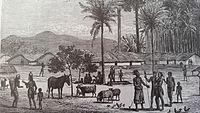Manyema: Difference between revisions
No edit summary Tags: Reverted Visual edit Mobile edit Mobile web edit |
No edit summary Tags: Reverted Visual edit Mobile edit Mobile web edit |
||
| Line 1: | Line 1: | ||
[[File:Manyema.jpg|thumb|200px|Manyema Village in 1876]] |
[[File:Manyema.jpg|thumb|200px|Manyema Village in 1876]] |
||
'''Manyema''' (Una-Ma-Nyema, eaters of flesh)<ref name=EB1911>{{cite EB1911 |wstitle=Manyema |volume=17 |page=626}}</ref> people are a tall, powerful, nomadic and in the past, warlike |
'''Manyema''' (Una-Ma-Nyema, eaters of flesh)<ref name=EB1911>{{cite EB1911 |wstitle=Manyema |volume=17 |page=626}}</ref> people are a tall, powerful, nomadic and in the past, warlike [[Bantu peoples|Sudanic-Bantu]] [[List of ethnic groups in Tanzania|people]]<ref name=EB1911/> in southeast of the [[Congo basin]] and in the [[Kigoma Region|Kigoma region]] of Western [[Tanzania]] who are believed to have migrated from Sudan and greater East Africa. |
||
In Tanzania, the Wamanyema includes various smaller tribes which are independent culturally but with striking resemblance due to intermarriages, including the [[Wagoma]], [[Wabwari]], Waholoholo, Wabuyu, Wamasanze, [[Bangubangu]], Wabembe and so on. Swahili-Arab referred to them all as '''Al ghamawiyyun''' |
In Tanzania, the Wamanyema includes various smaller tribes which are independent culturally but with striking resemblance due to intermarriages, including the [[Wagoma]], [[Wabwari]], Waholoholo, Wabuyu, Wamasanze, [[Bangubangu]], Wabembe and so on. Swahili-Arab referred to them all as '''Al ghamawiyyun''' |
||
Revision as of 13:32, 2 March 2022

Manyema (Una-Ma-Nyema, eaters of flesh)[1] people are a tall, powerful, nomadic and in the past, warlike Sudanic-Bantu people[1] in southeast of the Congo basin and in the Kigoma region of Western Tanzania who are believed to have migrated from Sudan and greater East Africa.
In Tanzania, the Wamanyema includes various smaller tribes which are independent culturally but with striking resemblance due to intermarriages, including the Wagoma, Wabwari, Waholoholo, Wabuyu, Wamasanze, Bangubangu, Wabembe and so on. Swahili-Arab referred to them all as Al ghamawiyyun
The Wamanyema people was for the greater part of the 14th to 19th centuries an Eldorado of the Swahili-Arab traders who traded gold, copper (from the hinterlands of Congo Basin) and cattle in exchange for slaves, spices and weapons.
In the 20th century, they have made considerable contribution in fields such as soccer, music and politics.
See also
References
- ^ a b Chisholm, Hugh, ed. (1911). . Encyclopædia Britannica. Vol. 17 (11th ed.). Cambridge University Press. p. 626.
